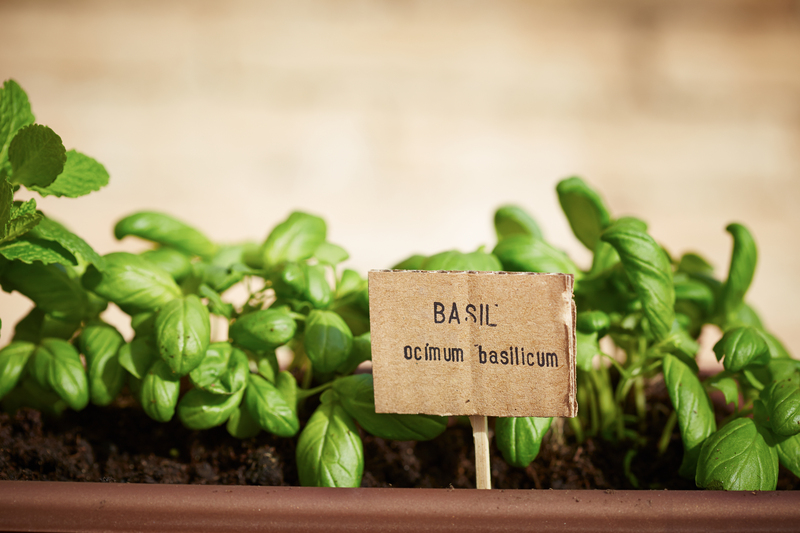Resilient Gardens: Weather-Proofing Against Nature's Wrath
Posted on 25/05/2025
Resilient Gardens: Weather-Proofing Against Nature's Wrath
Introduction: The Importance of Resilient Gardens
Nature's unpredictable temperament poses a continuous threat to our gardens. From scorching heatwaves and drought-like conditions to torrential rains, floods, and biting frosts, cultivating a resilient garden is no longer a choice--it's a necessity for gardeners worldwide. A weather-proof garden not only saves time, money, and labor, but also secures landscapes for future generations to cherish. In this comprehensive guide, we will explore practical strategies, expert recommendations, and eco-friendly techniques to help you build a truly resilient garden that can withstand the most challenging weather events nature can throw at it.

Understanding the Threats: What "Nature's Wrath" Means for Gardens
Resilient gardening starts with a deep understanding of the challenges your outdoor space faces. The most common threats include:
- Extreme heat and drought: Prolonged periods without rain can stress and damage sensitive plants.
- Heavy rains and flooding: Waterlogged soil and erosion can destroy garden beds and root systems.
- Frost and cold snaps: Sudden temperature drops can kill tender young plants.
- High winds: Gusts can break branches, uproot trees, and scatter mulch or topsoil.
- Pests and disease outbreaks: Weather extremes often correlate with surges in pest populations and disease.
By proactively addressing these weather risks, you lay the foundation for a more sustainable and enduring landscape.
Principles of Building a Resilient Garden
When it comes to weather-proof gardening, adopting a holistic approach is key. Consider these time-tested principles:
- Diversity: Planting a variety of species increases the chances that at least some will thrive through unpredictable weather.
- Soil Health: Healthy, living soil is better at absorbing water, resisting erosion, and supporting plant resilience.
- Water Management: Smart irrigation and rainwater harvesting reduce dependence on municipal water and prevent drought stress.
- Right Plant, Right Place: Choose plants suited to your local climate and microclimate for stronger, more robust growth.
- Flexible Design: Incorporate structures and layouts that can adapt to evolving weather patterns.
Soil: The Foundation of Every Resilient Garden
1. Building Healthy Soil for Climate-Resilient Gardens
Soil is the unsung hero of every successful weather-resilient landscape. Healthy soil acts as a sponge, retaining moisture during drought and draining efficiently during floods. Here's how to create resilient soil:
- Regularly add organic matter: Compost, shredded leaves, or well-rotted manure increase fertility and water retention.
- Practice no-till or low-till gardening: This protects the soil structure, preserves moisture, and encourages beneficial soil life.
- Test your soil: Periodic soil testing helps address deficiencies and prevent problems before they start.
- Mulch generously: Organic mulch retains moisture, lowers soil temperature, and breaks down to feed the soil.
2. Drainage: Preventing Flood Damage and Erosion
- Create swales and berms: These landscape features redirect excess water away from sensitive areas and facilitate slow absorption.
- Install French drains or dry wells: Consider these if your garden is prone to flooding or waterlogging.
- Plant ground covers: Fast-spreading plants help anchor soil on slopes and prevent erosion.
Investing in these foundational practices gives your storm-proof garden a fighting chance no matter what the forecast holds.
Choosing Weather-Resistant Plants
One critical element in designing a hardy garden is selecting plants that are naturally adapted to local conditions. Here are tips for making the right selections:
1. Native and Adaptive Species
- Native plants typically require less water, fertilizer, and pest control. They are suited to local climatic extremes and contribute to the ecological web.
- Drought-tolerant or xeriscaping plants can survive heat waves and prolonged dry spells. Consider succulents, ornamental grasses, or Mediterranean herbs.
2. Flood and Waterlogging-Resistant Varieties
- For areas prone to flooding or heavy rains, select water-loving plants like Iris, Canna, Dogwood, or Swamp Milkweed.
3. Wind and Salt-Tolerant Choices
- If your garden is exposed to high winds or near a coast, pick wind-resistant species like Pines, Junipers, and Wax Myrtle.
4. Creating Layered Plantings
- Mix trees, shrubs, perennials, and groundcovers: A multi-layered landscape traps wind, slows rainfall, and shades soil.
Tip: Consult your local extension office or nursery for region-specific advice on resilient plants for your area.
Weather-Proof Garden Design Strategies
Placing plants and structures purposefully can make your outdoor space more durable and better able to withstand extreme weather.
- Windbreaks: Use dense evergreen trees, hedges, or sturdy fencing to shield delicate plants from harsh winds.
- Raised beds: Elevate planting areas to prevent root rot in flood-prone locations.
- Rain gardens: Employ depressions planted with water-tolerant species to absorb stormwater runoff.
- Gravel paths and permeable surfaces: These facilitate drainage and prevent puddling during heavy rain events.
- Flexible support structures: Sturdy trellises, arbors, and cages can prevent breakage and help vines or tall plants survive windstorms.
The Role of Microclimates
Pay attention to your garden's microclimates--sunny, shaded, wet, or dry zones. Place cold-sensitive plants near masonry walls to benefit from radiant heat, or tuck moisture lovers in low-lying, wet spots.
Rainwater Management & Drought-Proofing Tips
1. Rainwater Harvesting
- Install rain barrels: Capture roof runoff for use during dry spells.
- Build swales: Shallow ditches slow down rainwater so it can soak into the soil rather than run off.
2. Drip Irrigation and Smart Watering
- Drip or soaker hoses: These target roots directly, reducing evaporation.
- Water early or late: Minimize evaporation and leaf scorch by watering in the early morning or evening.
- Group thirsty plants: Plant those that need more water together for efficient irrigation.
3. Mulching for Moisture Retention and Temperature Control
- Organic mulch (bark, straw, leaves): Keeps plant roots shaded and maintains soil moisture.
- Stone or gravel: These work well around succulents or xeriscapes, reflecting heat and preventing weed growth.
Preparing for Extreme Weather Events
Vigilance and preparedness are crucial for maintaining a resilient landscape. Here's how to get ready when weather warnings strike:
- Prune trees and shrubs: Remove weak or damaged branches before storms arrive.
- Secure outdoor structures: Stake or anchor loose items that could become projectiles in high winds.
- Install protective covers: Use frost blankets, cloches, or row covers for sudden cold snaps.
- Move containers indoors: If possible, move potted plants into a garage or sheltered space.
- Elevate valuable plants: In flood zones, place treasured containers on benches or shelves above ground level.
Integrated Pest and Disease Management
Extreme weather often leads to an uptick in pests and disease. A resilient, weather-resistant garden incorporates these tactics:
- Encourage beneficial insects: Ladybugs, lacewings, and hoverflies naturally control aphid outbreaks and other pests.
- Rotate crops and diversify plantings: This breaks pest life cycles and reduces vulnerability.
- Remove diseased plants promptly: Prevent spread of fungal or bacterial issues following stormy, humid weather.
- Practice good hygiene: Clean tools and quarantine new plants before introducing them to your garden.
Eco-Friendly Weatherproofing for Sustainable Gardens
Sustainability is at the heart of true resilient gardening. The more we work with nature, the stronger and more sustainable our gardens will be. Here are a few eco-friendly weatherproofing techniques:
- Plant dense hedges or shelterbelts: These block wind, create habitat for wildlife, and prevent soil erosion.
- Install green roofs or living walls: These moderate temperature swings and absorb stormwater.
- Compost: Reduces food waste, enriches the soil, and buffers plants against nutrient deficiencies caused by intense weather events.
- Minimize chemical use: Healthier soil and diverse plantings naturally resist pests and diseases.
Tip: By embracing these sustainable weather-proof gardening ideas, you help protect the planet while securing your garden's future.
Common Mistakes to Avoid in Building a Resilient Garden
- Overwatering during drought: Plants adapted to dry spells can rot if overwatered. Water deeply but less frequently.
- Ignoring frost dates: Planting too early or late risks crop failure and plant death.
- Using shallow-rooted plants exclusively: Deep-rooted plants help stabilize soil and access moisture during tough times.
- Relying on monocultures: Lack of diversity invites disaster if a pest or weather event targets a single species.
- Neglecting soil health: All the weather resistance in the world can't save a garden from poor, compacted, or depleted soils.

Resilient Gardens In Action: Real World Success Stories
- California Drought: Many home gardeners replaced thirsty lawns with native wildflower meadows, gravel gardens, and drought-tolerant perennials. Their gardens thrived as municipal water restrictions increased, providing nectar for pollinators and beauty for the community.
- Flood-Resistant Gardens in the UK: Creative use of rain gardens, permeable pavements, and raised vegetable beds allowed gardeners to bounce back quickly after seasonal river flooding.
- Urban Resilience: City dwellers in areas prone to heat have transformed balconies and rooftops into cooling, shaded oases using container plants, reflective mulches, and vertical gardening techniques.
Conclusion: Start Weather-Proofing Your Garden Today!
Creating a resilient, weather-proof garden is an ongoing journey requiring knowledge, creativity, and respect for the local environment. With climate change accelerating and weather patterns growing more erratic, today is the best time to start weatherproofing your landscape against nature's wrath.
- Focus on diversity, healthy soil, and smart water management.
- Choose adaptive, native, and resilient plant species for your area.
- Incorporate flexible designs, layered plantings, and eco-friendly techniques.
- Prepare for storms and be vigilant in maintenance.
By adopting these strategies, you ensure your garden's resilience--turning it into a beautiful, enduring oasis no matter what Mother Nature has in store.
If you're ready to embrace climate-proof gardening, share your progress and lessons learned with your local gardening community. Together, we can create a network of resilient landscapes that benefit both people and planet.

